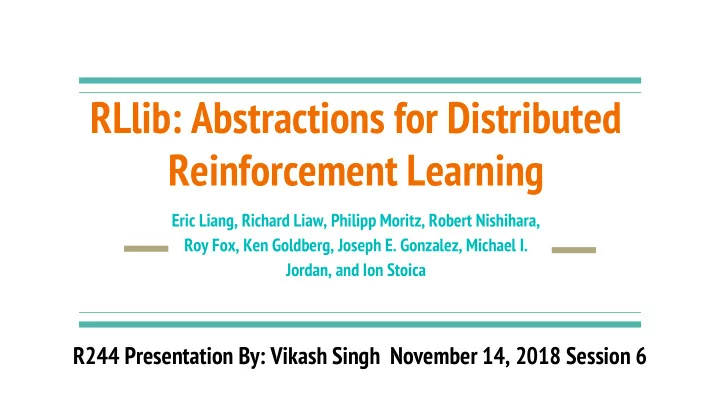

RLlib: Abstractions for Distributed Reinforcement Learning Eric Liang, Richard Liaw, Philipp Moritz, Robert Nishihara, Roy Fox, Ken Goldberg, Joseph E. Gonzalez, Michael I. Jordan, and Ion Stoica R244 Presentation By: Vikash Singh November 14, 2018 Session 6
What is Reinforcement Learning (RL) ? [4]
Understanding the Goal of RL Policy: Strategy used by the agent to determine which action to ● take given its current state Goal: Learn a policy to optimize long term reward ● [2]
Problem with Distributed RL ● Absence of a single dominant computational pattern or rules of composition ( e.g., symbolic differentiation) ● Many different heterogeneous components (deep neural nets, third party simulators) ● State must be managed across many levels of parallelism and devices ● People forced to build custom distributed systems to coordinate without central control!
Nested Parallelism in RL ○ ○ ● Opportunities for distributed computation in this nested structure! How to take advantage of this ?
RLlib: Scalable Software Primitives for RL ● Abstractions encapsulate parallelism and resource requirements ● Built on top of Ray [1] (task based system for distributed execution) ● Logically centralized top down hierarchical control ● Reuse of components for rapid prototyping, development of new RL algorithms
Hierarchical and Logically Centralized Control
Example: Distributed vs Hierarchical Control
Abstractions for RL ● Policy Graph : define policy (could be neural network in TF, Pytorch), postprocessor (Python function) , and loss ● Policy Evaluator: wraps policy graph and environment to sample experience batches (can specify many replicas) ● Policy Optimizer: extend gradient descent to RL, operates closely with the policy evaluator
Advantages of Separating Optimization from Policy Specialized optimizers can be swapped in to take advantage ● of hardware without changing algorithm Policy graph encapsulates interaction with deep learning ● framework, avoid mixing deep learning with other components Rapidly change between different choices in RL optimization ● (synchronous vs. asynchronous, allreduce vs parameter server, use of GPUs and CPUs, etc)
Common Themes in RL Algorithm Families
Complex RL Architectures using RLlib
RLlib vs Distributed TF Parameter Server Key Questions: Can a centrally controlled policy ● optimizer compete in performance with an implementation in a specialized system like Distributed TF [3] ? Can a single threaded controller ● scale to large throughputs?
Scalability of Distributed Policy Evaluation
More Performance Comparisons to Specialized Alternatives
Policy Optimizer Comparison in Multi-GPU Conditions
Minor Criticism ● Comparisons could be more exhaustive to cover more RL strategies ● Abstractions may be potentially limiting for newer models that don’t align with this paradigm ● Unclear how involved developer needs to be in resource awareness to achieve optimal performance
Final Thoughts ● RLlib presents a useful set of abstractions that simplify the development of RL systems, while also ensuring scalability ● Successfully breaks down RL ‘hodgepodge’ of components into separate, reusable components ● Logically centralized hierarchical control with parallel encapsulation prevents messy errors from coordinating separate distributed components
References 1. Moritz, Philipp, Robert Nishihara, Stephanie Wang, Alexey Tumanov, Richard Liaw, Eric Liang, William Paul, Michael I. Jordan, and Ion Stoica. "Ray: A Distributed Framework for Emerging AI Applications." arXiv preprint arXiv:1712.05889 (2017). 2. Seo, Jae Duk. "My Journey to Reinforcement Learning - Part 0: Introduction." Towards Data Science. April 06, 2018. Accessed November 06, 2018. https://towardsdatascience.com/my-journey-to-reinforcement-learning-part-0-intro duction-1e3aec1ee5bf. 3. Vishnu, Abhinav, Charles Siegel, and Jeffrey Daily. "Distributed tensorflow with MPI." arXiv preprint arXiv:1603.02339 (2016). 4. "KDnuggets." KDnuggets Analytics Big Data Data Mining and Data Science. Accessed November 06, 2018. https://www.kdnuggets.com/2018/03/5-things-reinforcement-learning.html.
Recommend
More recommend